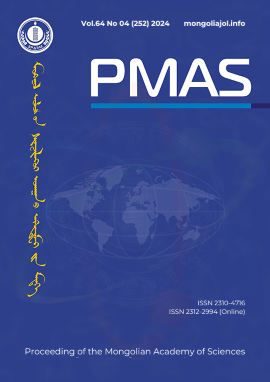Investigation on characterization of different types of coals and preparation of coal-derived activated carbon
DOI:
https://doi.org/10.5564/pmas.v64i04.3979Keywords:
High rank coal, bituminous coal, stone sub-bituminous coal, brown coal, activated carbon, surface areaAbstract
Activated carbon consumption is continuously increasing because of their application in such important areas as waste and drinkable water treatment, atmospheric pollution control, hazardous gas separation, cleaning of solvents, etc. Every year, Mongolia imports 700-800 tons of activated carbons for 700-900 USD per ton. We have selected 3 different types of coal, including a high ranking bituminous coal from Tavantolgoi deposit, stone sub-bituminous coal from Shariin Gol mine and brown lignite coal from Baganuur deposit and they were each enriched with heavy liquid, such as zinkum chlorade solution and processed by semicoking (carbonization) method to produce the main raw material for coal-derived active carbon. Using these carbonized coals, we have obtained coal-derived activeted carbon by activation with preheated water steam for 120 minutes. The most important technical properties of initial coal samples and activated carbons and their microporous properties, such as iodine number in percentage, methylene blue adsorption mg/g and surface area (BET)-m2/g were determined and characterized. The determined iodine number of activated carbon of purified and carbonized coals increased by 5-17 times and methylene blue adsorptions also increased from 4 to 10 times as compared to pyrolysis hard residue of initial coal samples without purification and activation. Basing on this, we are proposing a thecnological scheme for the production of coal-derived activated carbon.
Downloads
187
References
1. Purevsuren B., Davaajav. Ya., Erdenechimeg. R. Investigation of Some Large Coal Deposits in Mongolia. Monograph, ''Тооnot print'' Publisher. 2010. (13 print pages in Mongolian).
2. Avid. B., et al., Bituminous Coals of Mongolia: Occurrence and Characteristics. Advances in Energy Research. Editor Morena J.Acosta. Nova Publishers. New York, USA. 190 USD. 2015. V. 22. pp. 159-178.
3. Purevsuren. B., et al., Study of the Composition and Technological Properties of Coals from Mongolian Deposits. Chemistry of Solid Fuels (UDC 662.73:552). 2012. no. 3. pp. 9-13. https://doi.org/10.3103/S0361521912030123.
4. Jargalmaa. S., et al., Washability of Coal Seams IV and VIII of the Tavantolgoi Deposit. Natural Resources Research. 2015. V. 24. no 2. pp. 189-195. https://doi.org/10.1007/s11053-014-9245-9
5. Ariunaa. A., et al., Activated Carbon from Coal of Shariin Gol Deposit by Chemical Activation. Annual Scientific Reports of ICCT, MAS. 2007. No. 8 (34). pp. 22-26.
6. Purevsuren. B., et al., Characterization of Tars from the Thermal Processing of Baganuur and Tavantolgoi Coals from Mongolia, using SEC, UV-F, IR and Mass Spectrometry. Advances in Chemical Engineering and Science. 2013. No. 3(2). pp. 130-144. https://doi.org/10.4236/aces.2013.32016.
7. Purevsuren. B., et al., Study Results of High-speed Pyrolysis of Baganuur Brown Coal. Proceedings of the Mongolian Academy of Sciences. 1999. No. 2. pp. 32-37.
8. Ariunaa. A., et al., Activated Carbons from Mongolian Coals by Thermal Treatment. Mongolian Journal of Chemistry. 2011. No. 12(38). pp. 60-64. https://doi.org/10.5564/mjc.v12i0.174.
9. Batkhishig.D., et al., Preparation and Characterization of Activated Carbons from Different Kinds of Coal. Proceedings of the MAS. 2020. V. 60. No. 3(235). pp. 25-31. https://doi.org/10.5564/pmas.v60i3.1422.
10. Purevsuren. B., et al., Investigation of Adsorption of Methylene Blue from Aqueous Phase onto Coal-based Activated Carbons. Journal of the Chinese Institute of Engineers. 2017. V. 40, no. 4. pp. 355-360. https://doi.org/10.1080/02533839.2017.1308273.
11. Purevsuren.B., et al., Adsorption Isotherms and Kkinetics of Activated Carbons produced from Coals of DIfferent Ranks. Water Science & Technology, IWA Publishing. 2015. pp. 1189-1195. https://doi.org/10.2166/wst.2015.094.
12. Munkhjargal. Sh., et al., Products of Pyrolysis of Wood Wastes. Reports of the Institute of Chemistry and Chemical Technology, Mongolian Academy of Sciences. 1998. pp. 25-28.
13. Batbileg.S., Characterization of the Pyrolytic Products of Pine Nut Shell. International Journal of Chemistry. 2019. V.11. no 2. pp. 37-49. https://doi.org/10.5539/ijc.v11n2p37.
14. Purevsuren. B., et al., Thermal Analysis of Casein. Journal of Thermal Analysis and Calorimetry. 2001. V. 65. pp. 147. https://doi.org/10.1023/A:1011532819792.
15. Purevsuren. B., et al., Investigation on Pyrolysis of Casein. Journal of Thermal Analysis and Calorimetry. 2001. V. 66. pp. 743-748. https://doi.org/10.1023/A:1013135920477.
16. Purevsuren.B., Davaajav. Ya., Pyrolysis Hard Residue and Mineral Composition of Casein. Proceedings of the Mongolian Academy of Sciences. 1999. V. 151. No. 1. pp. 40-45.
17. Purevsuren. B., et al., Pyrolysis of Animal Bone, Characterization of the Obtained Char and Tar, Crosslinking of Epoxy Resin. Bulgarian Chemical Communications. 2017. V. 49. No. 1. pp. 34-39.
18. Purevsuren. B., at al., Investigation of the Pyrolysis Products from Animal Bone. Journal of Materials Science. 2004. V. 39. pp. 737-740. https://doi.org/10.1023/B:JMSC.0000011545.51724.ad.
Downloads
Published
How to Cite
Issue
Section
License
Copyright (c) 2024 Barnasan Purevsuren, Jargalsaikhan Namkhainorov, Sanjaa Batbileg, Soninkhuu Jargalmaa

This work is licensed under a Creative Commons Attribution 4.0 International License.
Copyright on any research article in the Proceedings of the Mongolian Academy of Sciences is retained by the author(s).
The authors grant the Proceedings of the Mongolian Academy of Sciences a license to publish the article and identify itself as the original publisher.

Articles in the Proceedings of the Mongolian Academy of Sciences are Open Access articles published under a Creative Commons Attribution 4.0 International License CC BY.
This license permits use, distribution and reproduction in any medium, provided the original work is properly cited.

